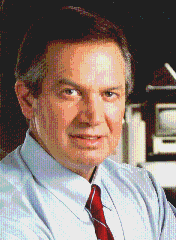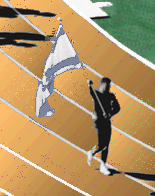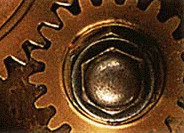Gideon B. Ariel, Ph.D. - Founder and chairman of Ariel Dynamics Inc.
 Dr. Gideon Ariel, Founder and Chief Executive of the Board
of Ariel Dynamics, Inc., is a world-renowned authority in biomechanics (the science
linking physics to movement of the human body) with special expertise in computer science.
He is a former Olympic athlete, and completed his graduate and post-doctoral work at the
University of Massachusetts, where he received a Ph.D. in Exercise and Computer Science.
He has published numerous scientific papers, has been featured on national TV and in many
magazines, holds several patents, (including one on variable resistance which is the basis
of most modem exercise equipment), served as consultant to many of the country's leading
companies, founded an independent laboratory devoted to biomechanical research relating to
human performance, and was chairman of the U.S. Olympic Biomechanical Committee.
Dr. Gideon Ariel, Founder and Chief Executive of the Board
of Ariel Dynamics, Inc., is a world-renowned authority in biomechanics (the science
linking physics to movement of the human body) with special expertise in computer science.
He is a former Olympic athlete, and completed his graduate and post-doctoral work at the
University of Massachusetts, where he received a Ph.D. in Exercise and Computer Science.
He has published numerous scientific papers, has been featured on national TV and in many
magazines, holds several patents, (including one on variable resistance which is the basis
of most modem exercise equipment), served as consultant to many of the country's leading
companies, founded an independent laboratory devoted to biomechanical research relating to
human performance, and was chairman of the U.S. Olympic Biomechanical Committee.
Dr. Ariel has been active in the fields of exercise and movementum
qantification for more than 30 years. He conducted the first scientific application of
anabolic steroids on Olympic athletic performance and the findings were published in
refereed journals and presented at conferences (23-37).
In 1968, Dr. Ariel invented the first rapid and accurate
computerized system to quantify the movement of Olympic athletes using the Newtonian laws
of motion. The first innovation in this initial system was a unique sonic digitizer which
was manufactured according to his specifications. This device allowed rapid conversion of
the athlete's performance, recorded on 16 mm film, into computer-ready joint center data.
The data was then processed by specialized software written by Dr. Ariel and his cadre of
programmers for operation on the computer at Dartmouth College.
A second company, Ariel Dynamics, Inc., was formed shortly
thereafter to focus on the development of products working with various corporations
including Wilson Sporting Goods and IBM Corporation. Dr. Ariel and his companies currently
hold twenty-nine patents and copyrights with other developments pending.
In 1968, Dr. Ariel founded Computerized Biomechanical
Analysis, to investigate the application of the emerging technology of computers to the
science of movement. When the development of the personal computer in the early 1980's
allowed the widespread use of his technology, Dr. Ariel began limited marketing of the
Ariel Computerized Exercise System (CES). Computerized Biomechanical Analysis, Inc.
(CBA),
since its inception, has been a leader in software development and scientific research
(50,51,59,72).
 Following the 1970 Training
camp studies, Dr. Ariel's involvement with the U.S. Olympic Committee continued. At that
time, the enthusiastic Head of the Sports Medicine Committee was Dr. Irving Dardik and Dr.
Ariel served with him as the Founding Chairman of Biomechanics (1976-1984). These two
dynamos were able to convince the Executive Director of the U.S. Olympic Committee, Col.
Miller, that a Training Center was essential for the preparation of the athletes and the
U.S. Olympic Training Center in Squaw Valley, CA was started for this purpose. Eventually
this Training Center was relocated in Colorado Springs, CO and a Biomechanics Laboratory
was established by Dr. Ariel in his role as Chairman of Biomechanics. Through Dr. Ariel's
efforts, most of the lab's equipment was donated including Data General's largest
computer; other corporations provided monitors, printers, etc. Additional modules for the
biomechanics laboratory resulted from Dr. Ariel's relinquishing his company's position in
favor of laboratory development; numerous studies were conducted for various sports
(38-49) with his guidance.
Following the 1970 Training
camp studies, Dr. Ariel's involvement with the U.S. Olympic Committee continued. At that
time, the enthusiastic Head of the Sports Medicine Committee was Dr. Irving Dardik and Dr.
Ariel served with him as the Founding Chairman of Biomechanics (1976-1984). These two
dynamos were able to convince the Executive Director of the U.S. Olympic Committee, Col.
Miller, that a Training Center was essential for the preparation of the athletes and the
U.S. Olympic Training Center in Squaw Valley, CA was started for this purpose. Eventually
this Training Center was relocated in Colorado Springs, CO and a Biomechanics Laboratory
was established by Dr. Ariel in his role as Chairman of Biomechanics. Through Dr. Ariel's
efforts, most of the lab's equipment was donated including Data General's largest
computer; other corporations provided monitors, printers, etc. Additional modules for the
biomechanics laboratory resulted from Dr. Ariel's relinquishing his company's position in
favor of laboratory development; numerous studies were conducted for various sports
(38-49) with his guidance.
Another contribution to the Biomechanics laboratory was Dr.
Ariel's insistence that a full time, biomechanically-qualified individual be hired for
on-site direction of the studies. The first person selected by Dr. Ariel to administer the
Colorado springs USOC Biomechanics Laboratory was Dr. Charles Dillman. Later, a number of
technicians were hired, including Phil Cheatham. Phil was working on some biomechanical
software modules using the source codes for Dr. Ariel's programs. Phil was innovative and
later started his own company.
 In addition to his
contributions in biomechanics, Dr. Ariel has long maintained an interest in the field of
exercise (52-60). One of his consulting efforts for Universal Gym in the late 1960's and
early 1970's resulted in the first mechanism which enabled a fixed weight stack to vary
the resistance while the individual exercised (61-67). This patent covered the variable
resistance mechanisms as well as many cam applications. Pursuing his interests in exercise
and computerized technology inevitably led Gideon Ariel to invent an exercise system that
was actually controlled, not merely monitored, by a computer. This invention, the first
ever Computerized Exercise System, became known as the "CES." In typical Ariel
fashion, he has created a completely new, unique Resistive Exercise Dynamometer (RED),
which has recently been introduced to the public.
In addition to his
contributions in biomechanics, Dr. Ariel has long maintained an interest in the field of
exercise (52-60). One of his consulting efforts for Universal Gym in the late 1960's and
early 1970's resulted in the first mechanism which enabled a fixed weight stack to vary
the resistance while the individual exercised (61-67). This patent covered the variable
resistance mechanisms as well as many cam applications. Pursuing his interests in exercise
and computerized technology inevitably led Gideon Ariel to invent an exercise system that
was actually controlled, not merely monitored, by a computer. This invention, the first
ever Computerized Exercise System, became known as the "CES." In typical Ariel
fashion, he has created a completely new, unique Resistive Exercise Dynamometer (RED),
which has recently been introduced to the public.
The inspiration for the continuous improvements in the
exercise devices and the movement analysis system results from Gideon Ariel's pursuit of
superior performance in people and in products. For example, he contracted an electronics
specialist to develop the first frame-grabber board for video to give the user the ability
to store video images on the computers hard disk.  The
biomechanist then has the option of digitizing directly from the video tape or storing
those images for later retrieval and digitization. Other innovations developed or
incorporated into the system included more choices of smoothing algorithms, including
polynomial, cubic and quintic splines, and various filters, which could be applied to
different activities at the user's discretion. There is continuous development on the
laptop system. A mechanism which allows panning by one or more cameras and a now 120 Hz
camera are other examples of the individual and corporate goals of constantly striving to
improve the system. The budget for research and development always gets the funding; the
marketing and sales budgets are usually limited to Xerox copies. Always the best product
and best options, and enthusiasm for making the system even better. Never look for slick
marketing or fancy advertising - flash will never replace substance at Ariel Dynamics,
Inc.
The
biomechanist then has the option of digitizing directly from the video tape or storing
those images for later retrieval and digitization. Other innovations developed or
incorporated into the system included more choices of smoothing algorithms, including
polynomial, cubic and quintic splines, and various filters, which could be applied to
different activities at the user's discretion. There is continuous development on the
laptop system. A mechanism which allows panning by one or more cameras and a now 120 Hz
camera are other examples of the individual and corporate goals of constantly striving to
improve the system. The budget for research and development always gets the funding; the
marketing and sales budgets are usually limited to Xerox copies. Always the best product
and best options, and enthusiasm for making the system even better. Never look for slick
marketing or fancy advertising - flash will never replace substance at Ariel Dynamics,
Inc.
Today, Ariel technology is now being used by hospitals and
physical therapy and rehabilitation clinics, leading universities such as UCLA, University
of Maryland, University of Massachusetts, University of Michigan, University of Rochester,
University Stuttgart, Washington University, as well as governmental and scientific
institutions such as National Aeronautics and Space Administration (NASA), the U.S. Navy
and the U.S. Air Force.